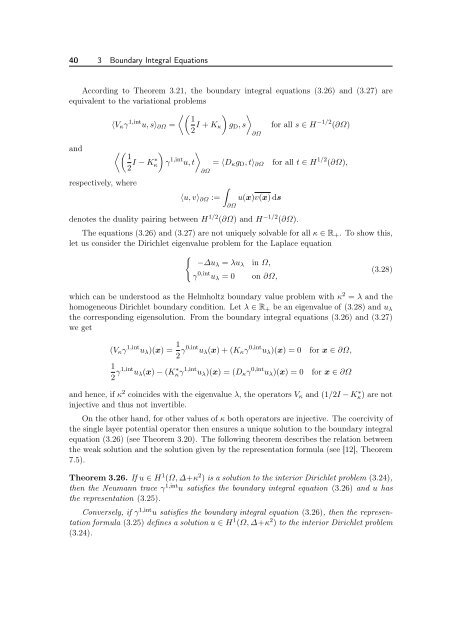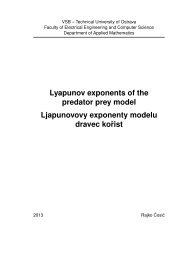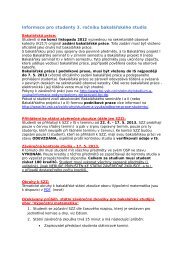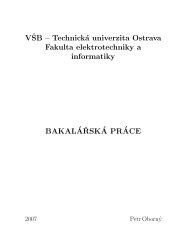The Boundary Element Method for the Helmholtz Equation ... - FEI VÅ B
The Boundary Element Method for the Helmholtz Equation ... - FEI VÅ B
The Boundary Element Method for the Helmholtz Equation ... - FEI VÅ B
You also want an ePaper? Increase the reach of your titles
YUMPU automatically turns print PDFs into web optimized ePapers that Google loves.
40 3 <strong>Boundary</strong> Integral <strong>Equation</strong>sAccording to <strong>The</strong>orem 3.21, <strong>the</strong> boundary integral equations (3.26) and (3.27) areequivalent to <strong>the</strong> variational problems 1⟨V κ γ 1,int u, s⟩ ∂Ω =2 I + K κ g D , s <strong>for</strong> all s ∈ H −1/2 (∂Ω)∂Ωand 12κI − K∗ γ 1,int u, t = ⟨D κ g D , t⟩ ∂Ω <strong>for</strong> all t ∈ H 1/2 (∂Ω),∂Ωrespectively, where⟨u, v⟩ ∂Ω :=∂Ωu(x)v(x) dsdenotes <strong>the</strong> duality pairing between H 1/2 (∂Ω) and H −1/2 (∂Ω).<strong>The</strong> equations (3.26) and (3.27) are not uniquely solvable <strong>for</strong> all κ ∈ R + . To show this,let us consider <strong>the</strong> Dirichlet eigenvalue problem <strong>for</strong> <strong>the</strong> Laplace equation−∆uλ = λu λ in Ω,γ 0,int (3.28)u λ = 0 on ∂Ω,which can be understood as <strong>the</strong> <strong>Helmholtz</strong> boundary value problem with κ 2 = λ and <strong>the</strong>homogeneous Dirichlet boundary condition. Let λ ∈ R + be an eigenvalue of (3.28) and u λ<strong>the</strong> corresponding eigensolution. From <strong>the</strong> boundary integral equations (3.26) and (3.27)we get(V κ γ 1,int u λ )(x) = 1 2 γ0,int u λ (x) + (K κ γ 0,int u λ )(x) = 0 <strong>for</strong> x ∈ ∂Ω,12 γ1,int u λ (x) − (K ∗ κγ 1,int u λ )(x) = (D κ γ 0,int u λ )(x) = 0 <strong>for</strong> x ∈ ∂Ωand hence, if κ 2 coincides with <strong>the</strong> eigenvalue λ, <strong>the</strong> operators V κ and (1/2I − K ∗ κ) are notinjective and thus not invertible.On <strong>the</strong> o<strong>the</strong>r hand, <strong>for</strong> o<strong>the</strong>r values of κ both operators are injective. <strong>The</strong> coercivity of<strong>the</strong> single layer potential operator <strong>the</strong>n ensures a unique solution to <strong>the</strong> boundary integralequation (3.26) (see <strong>The</strong>orem 3.20). <strong>The</strong> following <strong>the</strong>orem describes <strong>the</strong> relation between<strong>the</strong> weak solution and <strong>the</strong> solution given by <strong>the</strong> representation <strong>for</strong>mula (see [12], <strong>The</strong>orem7.5).<strong>The</strong>orem 3.26. If u ∈ H 1 (Ω, ∆+κ 2 ) is a solution to <strong>the</strong> interior Dirichlet problem (3.24),<strong>the</strong>n <strong>the</strong> Neumann trace γ 1,int u satisfies <strong>the</strong> boundary integral equation (3.26) and u has<strong>the</strong> representation (3.25).Conversely, if γ 1,int u satisfies <strong>the</strong> boundary integral equation (3.26), <strong>the</strong>n <strong>the</strong> representation<strong>for</strong>mula (3.25) defines a solution u ∈ H 1 (Ω, ∆+κ 2 ) to <strong>the</strong> interior Dirichlet problem(3.24).









